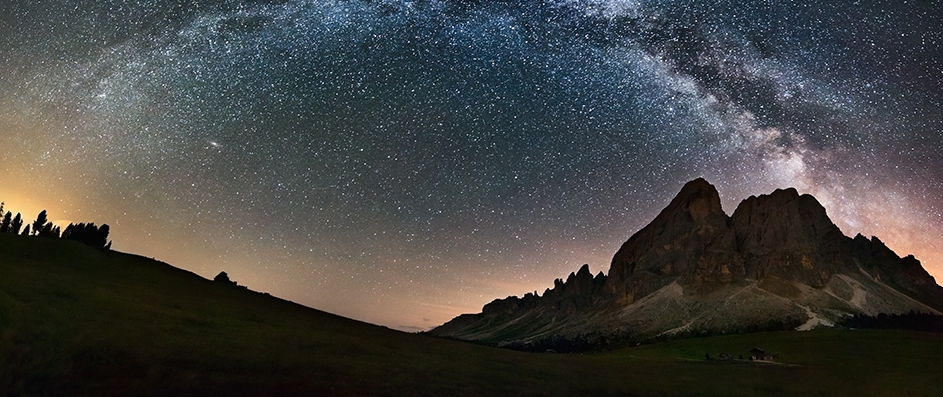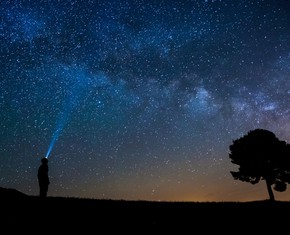The views expressed in our content reflect individual perspectives and do not represent the authoritative views of the Baha'i Faith.
If everything goes as planned between now and then, a rocket will launch from the European Spaceport near Kourou, French Guiana in South America during October of 2018. The unique multinational payload of that rocket, called the James Webb Space Telescope (JWST), will then allow human beings to discover how the first galaxies formed, and whether we’re alone in the cosmos.
Is science awesome, or what?!
This breakthrough global project, a joint effort of NASA, the Canadian Space Agency and the European Space Agency, brings twenty nations together in the interest of truly seeing deeply into the origins of the universe for the very first time. The James Webb Space Telescope will cost, if current budget estimates hold, almost $9 billion dollars.
Whoa. Sure, science is awesome, but is it $9 billion worth of awesome? For a telescope? Lots of people think that we could spend that huge amount of money on other things—schools, feeding and housing the homeless, preventing disease or dealing with lots of other pressing issues right here on this planet.
But despite my background working on issues like health care and homelessness, and my passion about those issues, I’d like to make a case for that expensive telescope.
Why? Well, the Baha’i teachings say that religion and science should go hand in hand:
…among the teachings of Baha’u’llah is that religion must be in conformity with science and reason, so that it may influence the hearts of men. – Abdu’l-Baha, Selections from the Writings of Abdu’l-Baha, p. 299.
Religion and Science are inter-twined with each other and cannot be separated. These are the two wings with which humanity must fly. One wing is not enough. Every religion which does not concern itself with Science is mere tradition, and that is not the essential. Therefore science, education and civilization are most important necessities for the full religious life. – Abdu’l-Baha, Abdu’l-Baha in London, pp. 28-29.
Normally, people don’t think about religion and science this way. We often see them as separate or even competing domains. But from a Baha’i perspective, they’re really one and the same. One of the primary Baha’i principles—the essential unity of science and religion—emphasizes their powerful connection. When Abdu’l-Baha said that “science, education and civilization are most important necessities for the full religious life,” it gave science and spirituality a new way to relate to each other.
The way Baha’is see it, each human being has a mind and a soul. Our minds have reasoning power, scientific insight, the ability to ask penetrating questions and find the answers. Our souls supply the motivation, the curiosity, the burning desire to know things. Together, the mind and the soul work in tandem to make us fully human:
The human spirit, which distinguishes man from the animal, is the rational soul, and these two terms—the human spirit and the rational soul—designate one and the same thing. This spirit, which in the terminology of the philosophers is called the rational soul, encompasses all things and, as far as human capacity permits, discovers their realities and becomes aware of the properties and effects, the characteristics and conditions of earthly things. But the human spirit, unless it be assisted by the spirit of faith cannot become acquainted with the divine mysteries and the heavenly realities. It is like a mirror which, although clear, bright, and polished, is still in need of light. Not until a sunbeam falls upon it can it discover the divine mysteries.
As for the mind, it is the power of the human spirit. The spirit is as the lamp, and the mind as the light that shines from it. The spirit is as the tree, and the mind as the fruit. The mind is the perfection of the spirit and a necessary attribute thereof, even as the rays of the sun are the essential requirement of the sun itself. – Abdu’l-Baha, Some Answered Questions, newly revised edition, pp. 241-242.
That’s why we need this powerful new telescope—so we can acquaint ourselves with the heavenly realities. That’s the core of what it means to be human—curiosity coupled with spiritual capacity.
Why are we like this? Well, why do hikers always want to see what’s around the next bend? Why do mountain climbers always want to ascend the next peak? Why do athletes want to set records? Why do we even care how the universe formed, or what makes the atmosphere heat up, or how to make things better? Why do we yearn to know more than we knew yesterday? We do those things because humans aren’t content to simply live their lives without questioning things, discovering new frontiers and solving mysteries. We do these things because we have an innate inner desire to know. We do these things because we’re natural explorers, searchers and seekers. We do these things because we have souls.
That’s what the JWST will help accomplish—it will allow us to know more about where we came from, and where our universe came from. It will answer some of the questions our souls have always asked. It’s just a powerful telescope, but its main scientific mission has four major goals:
- to search for light from the first stars and galaxies that ever formed,
- to study the formation and evolution of galaxies,
- to understand the formation of stars and planetary systems,
- and to study the origins of life.
Pretty amazing. Oh, and one more thing: the JWST will gather information about the most mysterious interstellar object we’ve ever discovered, KIC 8462852, the star that regularly dims and brightens as if it might have some kind of “mega-structure” built around it.
Won’t that be incredibly awesome?
Want to know more about the KIC 8462852 mystery? Read our last series on this fascinating subject here: Have We Discovered Another Civilization in Space?
















Comments
Sign in or create an account
Continue with Googleor